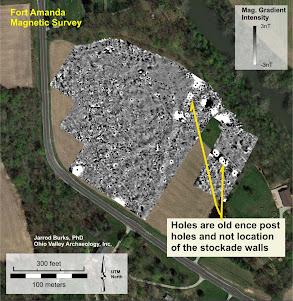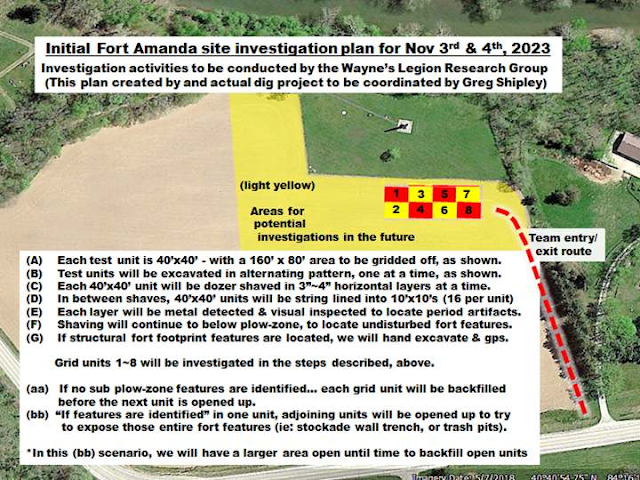The first archaeological work, of any kind, ever done at the Fort Amanda site was performed in 2013 by a team from Ohio Valley Archaeology Inc. (Columbus, Ohio) led by Dr. Jarrod Burks. While the scans did not specifically identify any major features, i.e., buildings, it did identify areas to concentrate on for any future work. Thinking that any "future work" would probably never happen in my lifetime, little did I know at the time that, 5 years later, I would meet Greg Shipley, an amateur archaeologist from Logan County who, along with his team, may help answer many of the questions surrounding Fort Amanda that have been left unanswered for more than 211 years.
Fort Amanda Archaeology Begins
In 2023, Greg contacted me and said he was interested in doing some premliminary test digs in the field adjacent to the monument area at Fort Amanda. He approached the owner of the field, David Kreigel and asked for permission to scrape the dirt away to below below the plow zone in a specified area in his field . David, who I might add, has the same passions for history and Fort Amanda as many of us, not only gave permission he provided the team with a bulldozer to scrape away the soil. Greg and his team started work on Nov. 3 and found more artifacts in two days than I had in years.
The Plan
Nov. 3 & 4, 2023
Shipley's notes
Last Friday and
Saturday, Nov 3rd & 4th, Wayne's Legion Research Group conducted
test excavations activity in the field west of the monument in a privately
owned farm field property. After obtaining permission and support from the
landowner (David Kreigel) and having studied research info and geophysical data
supplied to me by David Johnson, the author of two published books about this
War of 1812 Ohio fort site, we laid out an area where our group's Phase1 plans
are to investigate eight connected 40'x40' grid units in the farm field that
adjoins the western side of the state owned Fort Amanda park - which has never
had any archaeological excavations conducted on the state's property,
whatsoever.
As with how we conduct investigations in agriculturally disturbed farm fields, we metal detected and mapped in recovered materials: first, from the surface, then, in between each 3" horizontal layer of, already disturbed, farm field plow-zone that is dozed off. Each new surface was searched and metallic + visible non-metallic artifacts were recovered and mapped in on my data tracking. After the initial surface residue's back drag and three full shave processes, each 40'x40' unit's depths were to the bottom of old tillage layer and we began to, either, see nothing but natural soil strata or... the outlines of deeper disturbed features of the fort period. While much of the sub plow-zone strata was completely natural in appearance, we located five fire pit / trash pit features, which contained charred wood, ash, splintered animal bones (discarded remains of soldier's meals), and many fort related artifacts: musketballs, buck shots, gunflints, puddled lead and brass, forged iron nails, various button types (flat brass, tombac, and pewter), a hand made iron fork, harness buckles, etc.
Shipley's Notes
A 1780 Spanish silver 1Reale coin was recovered, along with
a trade silver bob ornament and cut pieces of Indian trade silver. Our GPS
data, for each feature and our excavation units, allowed me to find those
coordinates on Google Earth satellite imaging and apply the thumbtack points
for the located fire pits (trash pits) on this post's images. Also, I
photographed the artist's image of the expected layout of Ft Amanda (from Dave
Johnson's book cover) and overlaid it on my Google Earth image to show proximity
of the fort's location, to where we conducted our first four grid unit
excavations. We'll complete the last four units of this Phase1 investigation,
with our next site activity. We plan to gradually investigate the entire field
area along the two sides that adjoins the park's perimeter.
All recovered
materials are separated by unit and by the individual features they were
recovered in. As I complete the cleaning, preservation, & cataloging
processes, I'll be posting photos of the several hundred items that we've
recovered, already.
My thanks go out to Mr David Kriegel (property owner) for his full
support and to Mr David Johnson (Ft Amanda researcher and author) for all of
his shared research information. Both of these gentlemen were present and
enjoyed getting to see the exposed fort period features, firsthand. Last of
all, I have to thank all of my WLRG teammates and friends, who gave their time,
labor, and travel expenses, freely, so that new information about another
largely ignored Ohio historical site could be made public. Huzzah!

Shipley's Notes
After Doug Penhorwood had finished dozing our Fort
Amanda site excavation area back in and our group members had handworked
everything, nice and level, we did some field surface metal detecting in areas
I'll want to excavate, next year. One very good detector signal ended up being
this 1780 Spanish silver 1Reale coin, which I dug from only six inches of depth
in the disturbed plow-zone layer of this farm field. Both sides of this 243
year old coin exhibit scars from being churned around by agricultural tillage
activities but it is always a thrill to find a coin, from Spain's colonial
period, on an Ohio historical site. This is the first fort period coin to be
recovered during our Wayne's Legion Research Group activities on this War of
1812 site but, hopefully, more will come to light, during future excavations,
here.
Shipley's Notes
For me, this wonderful hand forged 2-tine fork is the most important artifact recovery made, during our two day test dig at the Fort Amanda site (War of 1812 era), last week. This eating utensil was found in one of the undisturbed (sub plow-zone) fire pit/ trash midden features that we located and excavated in the Kriegel farm field property that borders the Ft Amanda park.
I've completed the cleaning and preservation processes
on this blacksmith made item, along with the acorns that I discovered were in
the masses of ash and charred wood that I've been carefully going through and
cleaning. The meat of one acorn is still in the half shell, even. A few English
soft-paste china tea cup fragments and olive glass bottle shards were mixed
into splintered animal bones, along with brass and tombac buttons, a cuff-link,
a gunflint, musket and rifle balls, a buck shots, cut mold sprue caps, melted
lead blobs, corroded iron nails, etc. Most fascinating discoveries related to
the 1812~1814 occupation of the Ohio fort site, in Auglaize County, Ohio
%20-%20Copy.jpg)





.JPG)










.jpg)
%20-%20Copy.jpg)
.jpg)
.jpg)


